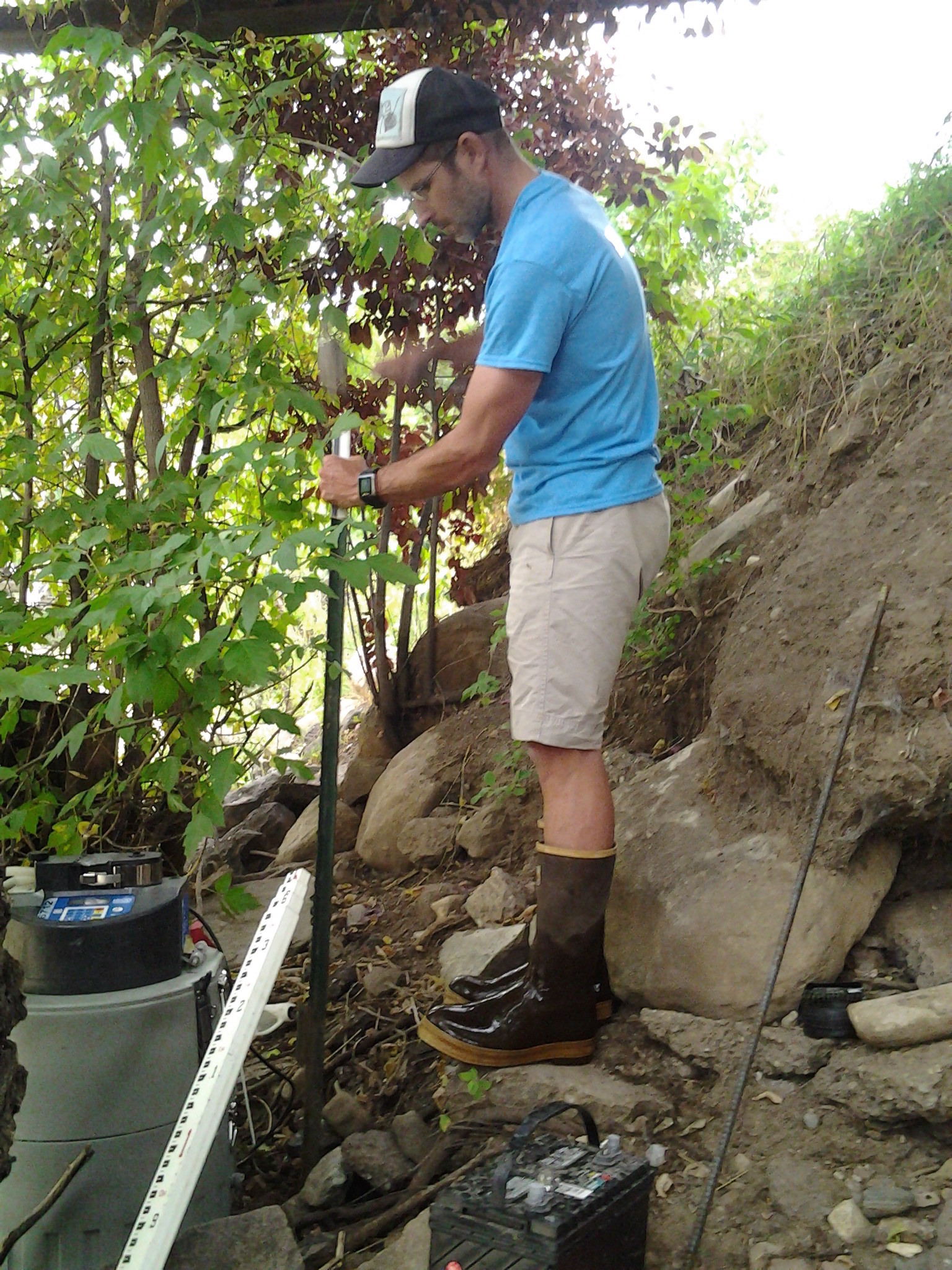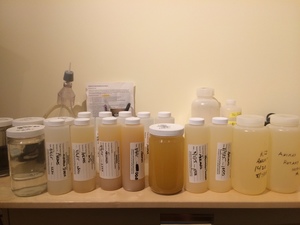For updates on current Animas River monitoring please visit our new Animas River portal:
8/1/2016 - MSI releases report that EVALUATES the impacts to Animas River benthic macroinvertebrate populations from the August 2015 Gold King Mine release.
Mountain Studies Institute (MSI) surveyed benthic macroinvertebrate (BMI) populations along the Animas River from Silverton to Durango and analyzed potential impacts to these populations from the Gold King Mine release. MSI analyzed the immediate survival of benthic insects and also compared observations of BMI populations from the fall of 2014, prior to the Gold King Mine release, to the fall of 2015, two months after the release.
Gold King Spill Aug.2015 - Did the Animas River exceed water quality standards?
Y (with yellow highlight) = indicates that for the listed metal, at least one sample had a concentration that surpassed water quality benchmarks;
Y* = Indicates that for the listed metal, at least one sample briefly surpassed a chronic or 30-day water quality benchmark. However, the 50th percentile (or 85th percentile, depending on the standard) must be surpassed over a 30-day period in order to suggest cause for concern.
Y**= Indicates that when applied to the total recoverable metal concentration, at least one sample briefly surpassed the EPA Recreational Screening Level. However, similar to chronic water quality benchmarks, the EPA Recreational Screening Level represents risk from persistent prolonged exposure. Since concentrations only briefly surpassed the EPA Recreational Screening Level, it does not indicate potential harm. See the Recreation section of this report for more details.
n = indicates that for the listed metal, no samples had concentrations that surpassed water quality benchmarks.
- = indicates there is no water quality benchmark for this analyte at this geographic location.
MSI Water sampling location in Durango, CO. Click to enlarge.
At Rotary Park, we detected metal concentrations that surpassed water quality standards that have been set to protect aquatic life and domestic water supply. Aluminum concentrations from samples collected at 12 AM and 12:30 AM on August 7th were higher than the Colorado Department of Public Health and the Environment (CDPHE) Aquatic Life Acute Standard. Lead concentrations from six samples collected on August 6th and August 7th surpassed the CDPHE Domestic Water Supply Maximum Contaminant Level. We did not detect any metal concentrations that surpassed water quality benchmarks from August 8th to October 26th.
AQUATIC LIFE
These results suggest that during the plume, high concentrations of aluminum may have been detrimental to aquatic life in the Animas River at Rotary Park. However, observations from Colorado Parks and Wildlife and the Mountain Studies Institute confirmed that fish and benthic macroinvertebrates in the Durango stretch of the Animas River largely survived the Gold King Mine release (MSI, unpublished; White 2016). Sub-lethal impacts to aquatic life, such as reduced reproduction potential, are possible and should be examined by assessing the survival of subsequent generation of fish and benthic macroinvertebrates.
DOMESTIC WATER SUPPLY
The CDPHE Domestic Water Supply Maximum Contaminant Levels (MCL) are set to protect the use of surface water for domestic water supply. Although some domestic water supply MCLs are set to represent chronic 30-day exposure, the MCL for lead is set to represent acute 1-day exposure. On August 6th and August 7th at Rotary Park in Durango, we detected concentrations of lead that surpassed the domestic water supply MCL for lead. However, during the August 6th and August 7th time period when we detected high concentrations of lead in the Animas River, the City of Durango had preemptively shut off its intake valve so that the city did not receive any drinking water from the Animas River during that time.
RECREATION
The EPA Recreational Screening Levels were set to represent the level at which no adverse health effects are expected to occur in humans consuming two liters of water per day, from the Animas, orally, for 64 days each year for 30 years.
To account for intentional ingestion of filtered Animas River water by recreational users such as campers, hunters, or backpackers (i.e., users most likely to have a high level of exposure from ingesting large volumes of river water over a prolonged period of time), EPA Recreational Screening Levels are applied to dissolved metal concentrations. We did not detect any dissolved metal concentrations during the Gold King plume or subsequent storm events that surpassed EPA Recreational Screening Levels.
To account for unintentional ingestion of unfiltered Animas River water by recreational users such as boaters and tubers (e.g., accidentally swallowing water), or intentional ingestion by campers, EPA Recreational Screening Levels could also be applied to total metal concentrations. When applied to total metal concentrations, the EPA Recreational Screening Level threshold was briefly surpassed for arsenic, iron, lead, and thallium on August 6th and 7th, but those levels only lasted a few hours during the plume and did not persist over a 64 day period.
Therefore, according to the screening levels set by the EPA (applied to either dissolved or total metal concentrations), the Gold King Mine release did not pose a threat to recreationalists exposed to Animas River water at Rotary Park during or after the Gold King Mine release.
AGRICULTURE
The CDPHE Agricultural Water Quality Standards were set to protect the use of surface water for crop irrigation and as a drinking water source for livestock. The CDPHE Agricultural Water Quality Standards represent the level at which no adverse effects are expected to occur from chronic prolonged exposure over a 30-day period. On August 6th and 7th, we detected concentrations of copper and lead that surpassed CDPHE Agricultural Water Quality Standards. However, the CDPHE Agricultural Water Quality Standards for copper and lead are not applicable to the type of acute short-term exposure that occurred on August 6th and 7th; they are based on the maximum concentrations that are recommended for long-term continuous use on agricultural soils (EPA 1972). Metal concentrations detected from August 8th to October 26th were below CDPHE Agricultural Water Quality Standards.
HOW DID METAL CONCENTRATIONS DURING THE PLUME AND POST-PLUME PERIOD COMPARE WITH HISTORIC OBSERVATIONS?
Historic water quality data are available from The Rivers of Colorado Water Watch Network, commonly referred to as River Watch. River Watch volunteers have collected monthly water quality samples from several sites along the Animas River, including a monitoring location at the Colorado Parks and Wildlife fish hatchery (37.2813, -107.8733), which is located approximately 400 meters (1,300 feet) upstream from Rotary Park in Durango. Monthly samples are available from the hatchery monitoring location from 1992-1997 and 2001-2014. River Watch data are publicly available from the Colorado Data Sharing Network.
In order to assess whether metal concentrations at Rotary Park following the Gold King Mine release had returned to levels consistent with historical observed metal concentrations, we compared dissolved and total metals from historical River Watch data to 2015 Rotary Park data.
These data suggest that during the post-plume time period (August 10 to October 26, 2015) at Rotary Park, total and dissolved concentrations of aluminum, arsenic, cadmium, copper, iron, lead, manganese, selenium, and zinc returned to levels consistent, or lower than, historical observed metal concentrations from the Animas River.
Concentrations of total recoverable aluminum, copper, iron, lead, and zinc were clearly higher during the Gold King Mine plume than in any other sample since at least 2001. However, the historic River Watch data indicated that concentrations of total recoverable arsenic and selenium observed during the plume were not unprecedented; higher concentrations were documented in the 2001-2014 time period.
Photo Gallery - How did the Animas River change?






















Click to enlarge photos and read captions.
How are WQ samples collected and analyzed?
There are two main commonly used sampling techniques used to determine water quality, grab samples and composite samples. MSI deployed staff into the field at 10 am on Thursday to collect grab samples on the hour. A grab sample is a single sample taken at a specific time. The grab sample represents a snapshot of the water column at a certain time. MSI took grab samples by hand every hour until 4pm on Friday when staff installed an automated water sampling device... Click the photo to read the "Life of a Sample" report that details how WQ samples are collected and analyzed.
Background information on mining activity in the area
For background information on mining in the San Juan Mountains, see this informative video from the recent 2015 San Juan Mining & Reclamation Conference:






